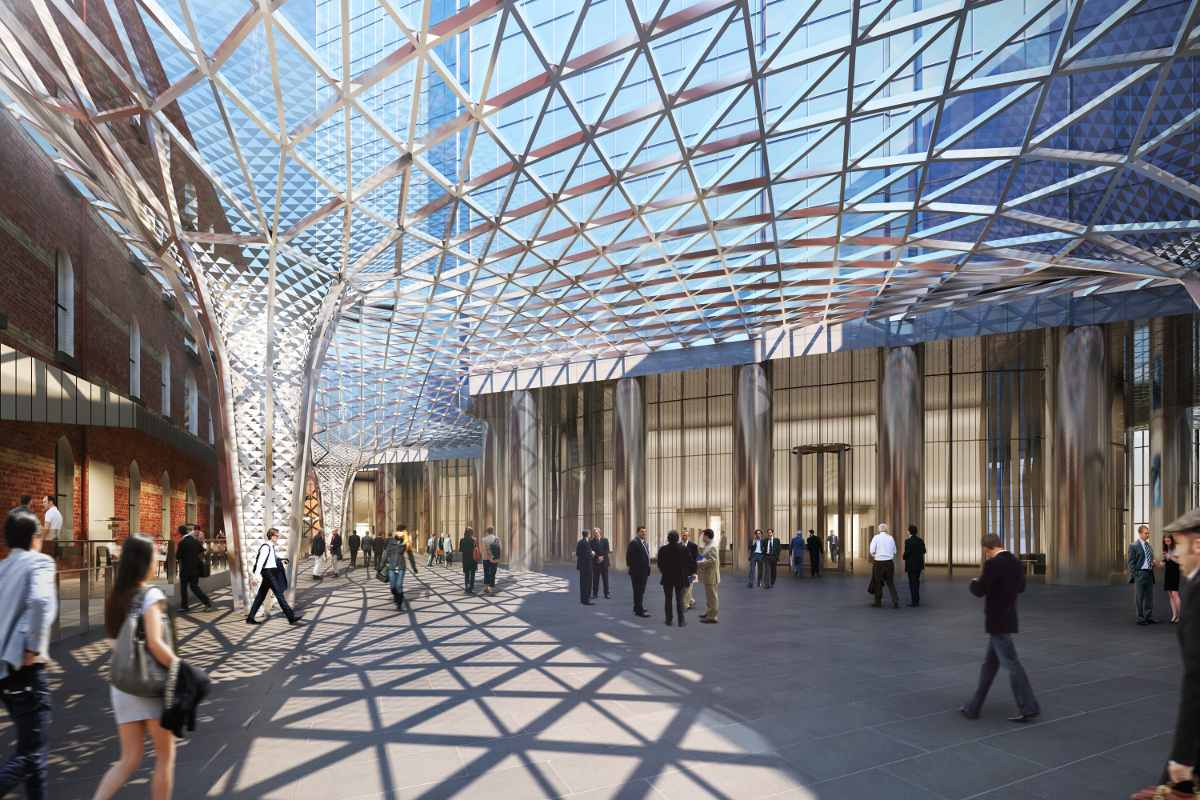
Until recent times, base builds had served as a de facto border between communal space and tenant entitlement—it was where all pedestrian activity ceased upon stepping off of the street, where security took over and a stern quiet ensued. However, as building owners become more open-minded and streetscapes evolve into more interactive, socially relevant, and culturally enriched spaces (as opposed to simply a place where people pass to get from point A to point B), the concept of base builds has transformed into something more welcoming and alive.
One such demonstration of this changing milieu is Woods Bagot's regeneration of the iconic Rialto Towers' base building, located at the historical district of Collins Street in Melbourne, Australia. The new six-storey base integrates office space with a food gallery and retail precinct, a new public realm that challenges the timeworn, closed-off characteristic of base buildings. Everything, from the amenities to the flow of the space, entreats the pedestrian to enter, move, and experience.
Because it is located in a historical area, the design approach had to be sensitive to the streetscape of the city block. The designers, led by Peter Miglis, used historical precedents as references for the new structure, as seen in the subtle echoes of the heritage landmark Robb's Building—which used to stand where the Rialto now does—in the new base build.

The rhythm of the façade seeks to match that of the area's historical character. The parapet levels, for instance, recall and amplify the roof silhouette of the buildings in the surrounding area, albeit in a more contemporary manner. "The design approach has been to rebuild the height and massing using similar building blocks to the historical grain," says Peter Miglis, principal designer at Woods Bagot.
The base structure's design does form a strong street-boundary line, but instead of being an unwelcoming presence to pedestrians, it acts as a "hinge," as Miglis describes it, to the Rialto Towers. Boundaries are set simply through textural and visual cues, using a shift in materials and finishes—bluestone for the forecourt, and brushed aluminum and black polished stone for the lift lobby.
At the plaza level, the pedestrian's footfall is hospitably guided along by two interlocking circles, forming a path that encourages exploration and easy navigation around the food gallery and business lounge. The retail area at Collins and Kings Streets align with the street level, and the horizontally positioned stone at the base melds seamlessly with the streetscape.
In terms of historical tribute, the roofscape, in particular, offers an interesting dimension: the varying levels look different from every angle, whether from the upper floors of the Rialto Towers or at street level. The design strives to mimic the playfulness of the heritage buildings along Collins Street. But these forms have function, as the upper floors of the base building serve as office spaces. Recessed terraces run between these spaces, which also enclose plant areas within the structure. Thus, the new base build as exemplified by the Rialto regeneration has become a mixed-use typology, allowing for transparency and privacy, flexibility and productivity.
 A likely catalyst for the typology shift is the fact that even the most well-built heritage structures are approaching the end of their life cycles. Although it is often an onerous undertaking to redefine such historically and physically monumental structures, it is arguably more difficult to go against the tide of modernization. And for building owners, modernization isn't just an abstract concept—it is palpable in prospective tenants' demands for more diverse and more accessible amenities that do not just cater to their workplace needs but also to their lifestyle and retail needs.
A likely catalyst for the typology shift is the fact that even the most well-built heritage structures are approaching the end of their life cycles. Although it is often an onerous undertaking to redefine such historically and physically monumental structures, it is arguably more difficult to go against the tide of modernization. And for building owners, modernization isn't just an abstract concept—it is palpable in prospective tenants' demands for more diverse and more accessible amenities that do not just cater to their workplace needs but also to their lifestyle and retail needs.
Thus, for Miglis, modernizing a cityscape is about "finding ways to ensure buildings remain an extension of the public realm," as lifestyle and retail, hospitality, food and beverage, and even public transport stations are all elements that allow for a healthy dose of public circulation.
"Melbourne City is transforming at a macro level; it’s gone from being a primarily focussed commercial entity to a precinct filled with residential, hospitality, food, culture, art, and sport. The city is a much more diverse place right through to its workplace settings," Miglis says.
For Ken Anderson, senior associate at Woods Bagot, the shift is both tenant-driven and asset-driven. "It's all about keeping the building as an asset up to date in the market," Anderson said. Miglis agrees: "Currently, the commercial market and existing landowners are facing a competitive environment, where existing tenants are looking for a greater amenity beyond their immediate workplace floors. This involves a broader precinct offer."
Working in a heritage building may work on the prestige aspect, but as newer buildings crop up, the competition for tenants becomes more cutthroat. To stay ahead of the competition, Anderson believes in transforming the more linear typologies to mixed-use ones. "New buildings come online with new technologies and new amenities," Anderson says. Large companies are more interested in cutting-edge buildings, for various reasons: safety concerns, freedom to accommodate more technologically advanced workplaces or commercial elements (such as advertising or display), maintaining brand and employee satisfaction, etc.

In the end, however, it is the ordinary pedestrian that enjoys the benefits of the base-build transformation. A simple typology change at the street level has inspired a cultural revolution, in which what used to be an enclosed, white-collar, starkly commercial "business district" is enlivened by a new influx of amenity that, with the increased engagement of the public sphere, encourages a constant evolution of the urban fabric. ![]()

